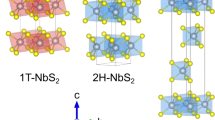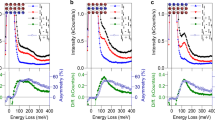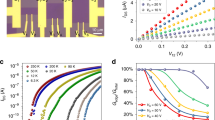Abstract
Electronic materials generally exhibit a single isotropic majority carrier type, electrons or holes. Some superlattice1,2 and hexagonal3,4,5 materials exhibit opposite conduction polarities along in-plane and cross-plane directions due to multiple electron and hole bands. Here, we uncover a material genus with this behaviour that originates from the Fermi surface geometry of a single band. NaSn2As2, a layered metal, has such a Fermi surface. It displays in-plane electron and cross-plane hole conduction in thermopower and exactly the opposite polarity in the Hall effect. The small Nernst coefficient and magnetoresistance preclude multi-band transport. We label this direction-dependent carrier polarity in single-band systems ‘goniopolarity’. We expect to find goniopolarity and the Fermi surface geometry that produces it in many metals and semiconductors whose electronic structure is at the boundary between two and three dimensions. Goniopolarity may enable future explorations of complex transport phenomena that lead to unprecedented device concepts.
This is a preview of subscription content, access via your institution
Access options
Access Nature and 54 other Nature Portfolio journals
Get Nature+, our best-value online-access subscription
$29.99 / 30 days
cancel any time
Subscribe to this journal
Receive 12 print issues and online access
$259.00 per year
only $21.58 per issue
Buy this article
- Purchase on Springer Link
- Instant access to full article PDF
Prices may be subject to local taxes which are calculated during checkout




Similar content being viewed by others
Data availability
All relevant data are available from the authors.
References
Zhou, C., Birner, S., Tang, Y., Heinselman, K. & Grayson, M. Driving perpendicular heat flow: (p × n)-type transverse thermoelectrics for microscale and cryogenic peltier cooling. Phys. Rev. Lett. 110, 227701 (2013).
Tang, Y., Cui, B., Zhou, C. & Grayson, M. p x n-type transverse thermoelectrics: a novel type of thermal management material. J. Electron. Mater. 44, 2095–2104 (2015).
Rowe, V. A. & Schroeder, P. A. Thermopower of Mg, Cd, and Zn between 1.2 degrees K and 300 degrees K. J. Phys. Chem. Solids 31, 1–8 (1970).
Burkov, A. T., Vedernikov, M. V., Elenskii, V. A. & Kovtun, G. P. Anisotropy of thermo-EMF and electroconductivity of high-purity rhenium. Fiz. Tverd. Tela 28, 785–788 (1986).
Burkov, A. T. & Verdernikov, M. V. Anomalous aniosotropy of high temperature thermo-EMF in beryllium. Sov. Phys. Solid State 28, 3737–3739 (1986).
Gu, J. J., Oh, H. W., Inui, H. & Zhang, D. Anisotropy of mobility ratio between electron and hole along different orientations in ReGexSi1.75-x thermoelectric single crystals. Phys. Rev. B 71, 113201 (2005).
Putley, E. H. The Hall Effect and Related Phenomena 85–90 (Butterworths, 1960).
Caswell, A. E. The Hall, Ettingshausen, Nernst, and Leduc effects in cadmium, nickel, and zinc. Phys. Rev. 20, 280–282 (1922).
Mangez, J. H., Issi, J.-P. & Heremans, J. P. Transport properties of bismuth in quantizing fields. Phys. Rev. B 14, 4381–4385 (1976).
Ong, K. P., Singh, D. J. & Wu, P. Unusual transport and strongly anisotropic thermopower in PtCoO2 and PdCoO2. Phys. Rev. Lett. 104, 176601 (2010).
Tanaka, M., Hasegawa, M. & Takei, H. Growth and anisotropic physical properties of PdCoO2 single crystals. J. Phys. Soc. Jpn 65, 3973–3977 (1996).
Cutler, M. & Mott, N. F. Observation of Anderson localization in an electron gas. Phys. Rev. 181, 1336–1340 (1969).
Harrison, W. Electronic Structure and the Properties of Solids: The Physics of the Chemical Bond 34 (Dover, 1989).
Jan, J.-P. Effective masses and curvature of the Fermi surface or energy bands. Helv. Phys. Acta 41, 957–959 (1968).
MacDonald, D. K. C. & Pearson, W. B. Thermo-electricity at low temperatures I. The ‘ideal’ metals: sodium, potassium, copper. Proc. R. Soc. Lond. A 219, 373–387 (1953).
Anderson, H. G. Jr. Investigation of Thermoelectric Properties of Liquid Metals MACHLAB-254 (David W. Taylor Naval Ship Research and Development Center, 1969).
Madsen, G. K. H. & Singh, D. J. BoltzTraP. A code for calculating band-structure dependent quantities. Comput. Phys. Commun. 175, 67–71 (2006).
Arguilla, M. Q. et al. NaSn2As2: an exfoliatable layered van der Waals Zintl phase. ACS Nano 10, 9500–9508 (2016).
Kresse, G. & Hafner, J. Ab initio molecular dynamics for liquid metals. Phys. Rev. B 47, 558–561 (1993).
Kresse, G. & Hafner, J. Ab initio molecular-dynamics simulation of the liquid-metal amorphous–semiconductor transition in germanium. Phys. Rev. B 49, 14251–14269 (1994).
Perdew, J. P., Burke, K. & Ernzerhof, M. Generalized gradient approximation made simple. Phys. Rev. Lett. 77, 3865–3868 (1996); erratum 78, 1396 (1997).
Blöchl, P. E. Projector augmented-wave method. Phys. Rev. B 50, 17953–17979 (1994).
Ong, N. P. Geometric interpretation of the weak-field Hall conductivity in two-dimensional metals with arbitrary Fermi surface. Phys. Rev. B 43, 194–201 (1991).
Førsvoll, K. & Holwech Sondheimer, I. Oscillations in the Hall effect of aluminium. Philos. Mag. 10, 921–930 (1964).
Ravich, Y. I, Efimova, B. A. & Smirnov, I. A. Semiconducting Lead Chalcogenides 111–113 (Plenum, 1970).
Fauqué, B. et al. Magnetoresistance of semi-metals: the case of antimony. Phys. Rev. Mater. 2, 114201 (2018).
Lin, Z. et al. Thermal conductivities in NaSnAs, NaSnP, and NaSn2As2: effect of double lone-pair electrons. Phys. Rev. B 95, 165201 (2017).
Heremans, J. P., Thrush, C. M. & Morelli, D. T. Thermopower enhancement in lead telluride nanostructures. Phys. Rev. B 70, 115334 (2004).
Acknowledgements
Primary funding for the synthesis (M.Q.A., N.D.C., M.R.S. and J.E.G.) and transport measurements (B.H. and J.P.H.) was provided by NSF EFRI-1433467. Primary funding for the DFT simulations was provided by the Center for Emergent Materials: an NSF MRSEC under Award DMR-1420451 (Y.W.) and AFOSR FA9550-18-1-0335 (W.W.). J.E.G. acknowledges the Camille and Henry Dreyfus Foundation for partial support. R. Ripley is acknowledged for editing text and figures.
Author information
Authors and Affiliations
Contributions
Measurements were carried out by B.H. and J.P.H.; the theory was developed by Y.W., J.P.H. and W.W.; the sample synthesis was carried out by M.Q.A., N.D.C., M.R.S. and J.E.G.; and all DFT computations were carried out by Y.W. and W.W. The paper was primarily written by B.H., Y.W., J.E.G., W.W. and J.P.H.
Corresponding author
Ethics declarations
Competing interests
The authors declare no competing interests.
Additional information
Publisher’s note: Springer Nature remains neutral with regard to jurisdictional claims in published maps and institutional affiliations.
Supplementary information
Supplementary Information
Supplementary Figures 1–6, Supplementary Notes 1–5, Supplementary References 1–10
Rights and permissions
About this article
Cite this article
He, B., Wang, Y., Arguilla, M.Q. et al. The Fermi surface geometrical origin of axis-dependent conduction polarity in layered materials. Nat. Mater. 18, 568–572 (2019). https://doi.org/10.1038/s41563-019-0309-4
Received:
Accepted:
Published:
Issue Date:
DOI: https://doi.org/10.1038/s41563-019-0309-4
This article is cited by
-
Thermoelectric Properties of Zintl Arsenide EuCuAs
Journal of Electronic Materials (2023)
-
Giant anomalous Nernst signal in the antiferromagnet YbMnBi2
Nature Materials (2022)
-
Demonstration of valley anisotropy utilized to enhance the thermoelectric power factor
Nature Communications (2021)
-
Polarity is a matter of perspective
Nature Materials (2019)



